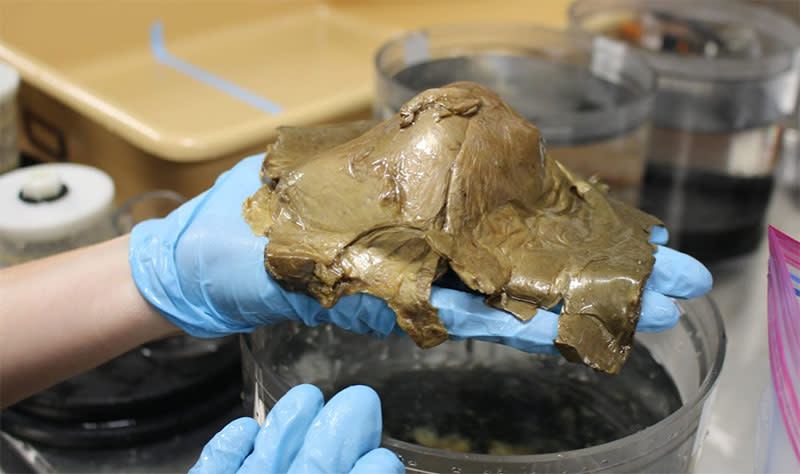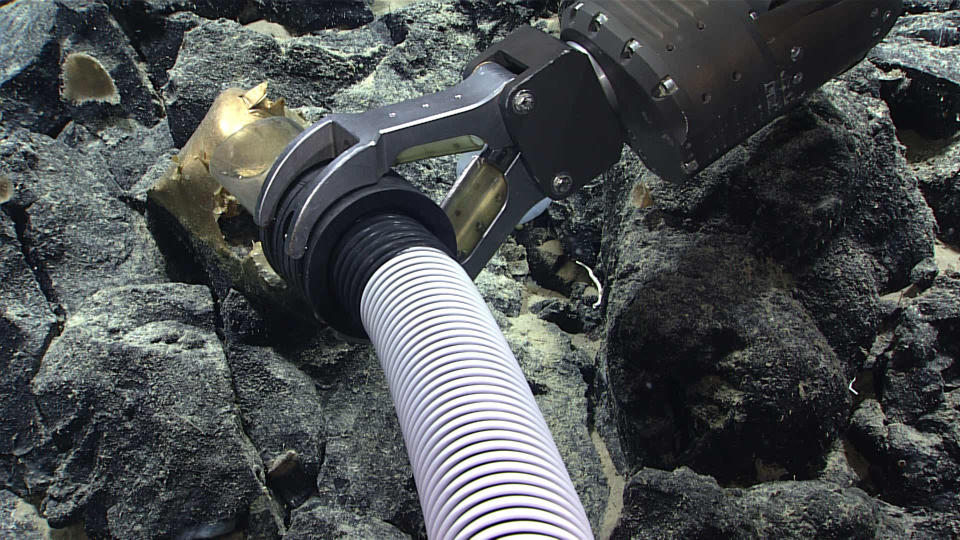The 'start of a horror movie?' Mysterious orb found on deep sea expedition

A lot lurks under the sea, and some of it is downright weird.
Here's the latest example. In what could be a page out of a science fiction novel, researchers on NOAA's Seascape Alaska 5 expedition have stumbled upon a mysterious metallic-looking blob in the waters off the coast of Alaska.
Measuring about 10 cm in diameter and adorned with a tannish-gold hue, the formation has raised many questions — mainly — what is this thing?
The National Oceanic and Atmospheric Administration (NOAA) announced this discovery on the social media platform X (formerly known as Twitter), saying it has "struck an imaginative chord" within the scientific community.
This golden orb, likely an egg casing, struck an imaginative chord for many watching yesterday.Today we dive on Denson Seamount. ROVs are launching & will remain on the seafloor until ~ 3:45pm ADKT/7:45pm EDT.Join us! https://t.co/ScOhpINB18#Okeanos #seascapealaska #explore pic.twitter.com/Eq1sYeVQrr
This golden orb, likely an egg casing, struck an imaginative chord for many watching yesterday.
Today we dive on Denson Seamount. ROVs are launching & will remain on the seafloor until ~ 3:45pm ADKT/7:45pm EDT.
Join us! NOAA Ocean Exploration on Twitter: "This golden orb, likely an egg casing, struck an imaginative chord for many watching yesterday.Today we dive on Denson Seamount. ROVs are launching & will remain on the seafloor until ~ 3:45pm ADKT/7:45pm EDT.Join us! https://t.co/ScOhpINB18#Okeanos #seascapealaska #explore pic.twitter.com/Eq1sYeVQrr / Twitter"NOAA Ocean Exploration on Twitter: "This golden orb, likely an egg casing, struck an imaginative chord for many watching yesterday.Today we dive on Denson Seamount. ROVs are launching & will remain on the seafloor until ~ 3:45pm ADKT/7:45pm EDT.Join us! https://t.co/ScOhpINB18#Okeanos #seascapealaska #explore pic.twitter.com/Eq1sYeVQrr / Twitter" NOAA Ocean Exploration on Twitter: "This golden orb, likely an egg casing, struck an imaginative chord for many watching yesterday.Today we dive on Denson Seamount. ROVs are launching & will remain on the seafloor until ~ 3:45pm ADKT/7:45pm EDT.Join us! https://t.co/ScOhpINB18#Okeanos #seascapealaska #explore pic.twitter.com/Eq1sYeVQrr / Twitter" NOAA Ocean Exploration on Twitter: "This golden orb, likely an egg casing, struck an imaginative chord for many watching yesterday.Today we dive on Denson Seamount. ROVs are launching & will remain on the seafloor until ~ 3:45pm ADKT/7:45pm EDT.Join us! https://t.co/ScOhpINB18#Okeanos #seascapealaska #explore pic.twitter.com/Eq1sYeVQrr / Twitter" NOAA Ocean Exploration on Twitter: "This golden orb, likely an egg casing, struck an imaginative chord for many watching yesterday.Today we dive on Denson Seamount. ROVs are launching & will remain on the seafloor until ~ 3:45pm ADKT/7:45pm EDT.Join us! https://t.co/ScOhpINB18#Okeanos #seascapealaska #explore pic.twitter.com/Eq1sYeVQrr / Twitter"— NOAA Ocean Exploration (@oceanexplorer) NOAA Ocean Exploration on Twitter: "This golden orb, likely an egg casing, struck an imaginative chord for many watching yesterday.Today we dive on Denson Seamount. ROVs are launching & will remain on the seafloor until ~ 3:45pm ADKT/7:45pm EDT.Join us! https://t.co/ScOhpINB18#Okeanos #seascapealaska #explore pic.twitter.com/Eq1sYeVQrr / Twitter"
The experts who first found the object got creative with their assessment, saying it looks like something you'd find "at the start of a horror movie" or in an X-Files episode.
More earthly speculations include an egg casing, coral, or encrusting sponges.
The orb was found during a routine deep-sea exploration mission on August 30. Using remotely operated vehicles (ROVs), scientists were mapping the Pacific Ocean when they happened upon the smooth, soft object clinging to a rock about 3 km beneath the surface.

The unidentified specimen, photographed in the wet lab on NOAA Ship Okeanos Explorer, was seen and collected on August 30, 2023, during Dive 07 of the Seascape Alaska 5: Gulf of Alaska Remotely Operated Vehicle Exploration and Mapping expedition. (NOAA Ocean Exploration, Seascape Alaska)
A small hole in the object was a notably intriguing detail, suggesting something may have entered or exited it.
The ROV extracted the object, which raised questions even after close inspection.
Sam Candio, the expedition's coordinator, says the next step involves transporting it to a more equipped on-land laboratory for further analysis.
"Isn’t the deep sea so delightfully strange?” Candio said in a statement.
“While we were able to collect the 'golden orb' and bring it onto the ship, we still are not able to identify it beyond the fact that it is biological in origin. We likely won't learn more until we are able to get it into a laboratory setting where we can continue to pull from the collective expertise of the scientific community with more sophisticated tools than we are able to maintain on the ship. While somewhat humbling to be stumped by this finding, it serves as a reminder of how little we know about our own planet and how much is left to learn and appreciate about our ocean.”

The specimen was collected using a suction sampler on remotely operated vehicle Deep Discoverer. (NOAA Ocean Exploration/Seascape Alaska)
It isn't uncommon for scientists to happen upon novel discoveries during exploratory missions, but they typically manage to classify them.
The Seascape Alaska 5 expedition, which began on August 23 in Kodiak, Alaska, and concludes on September 16 in Seward, Alaska, represents a comprehensive effort to explore uncharted regions in the Gulf of Alaska.
Employing ROVs and multibeam sonar technologies, scientists are probing depths ranging from 200 to 6,000 meters.
The mission aims to fill knowledge gaps about deep-sea habitats, ecosystems, and geological features.

